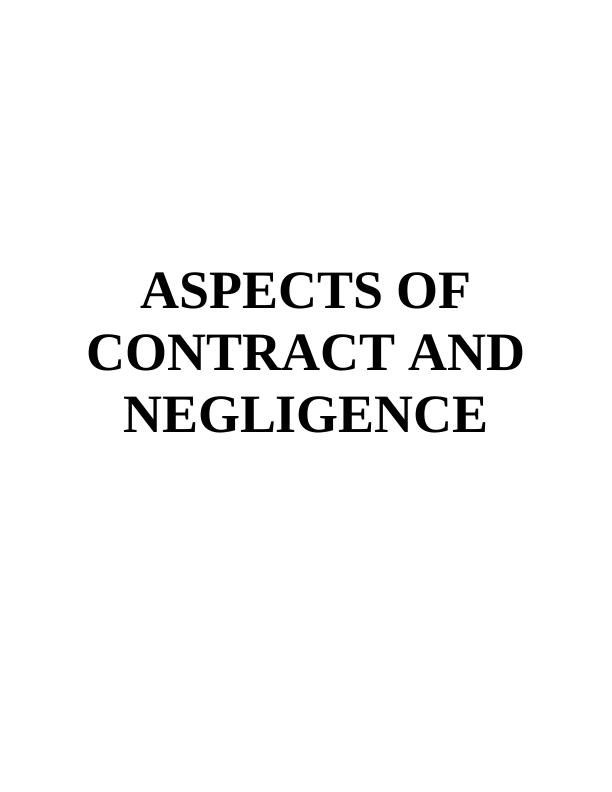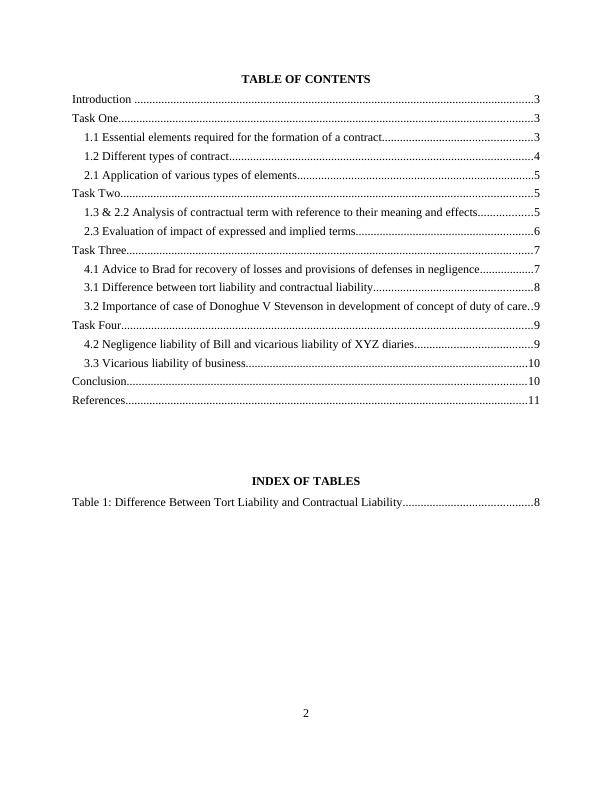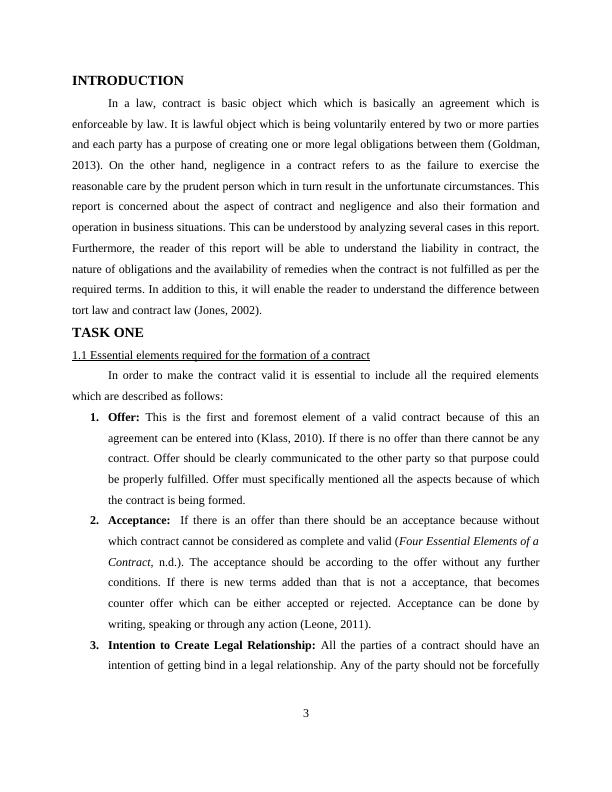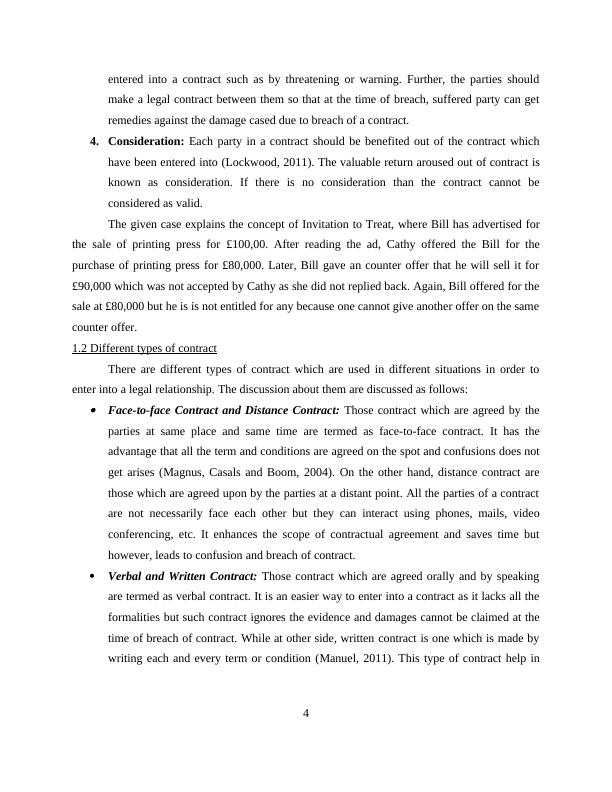Aspect of Contract and Negligence
12 Pages4068 Words148 Views
Added on 2019-12-03
Aspect of Contract and Negligence
Added on 2019-12-03
ShareRelated Documents
ASPECTS OFCONTRACT ANDNEGLIGENCE

TABLE OF CONTENTSIntroduction .....................................................................................................................................3Task One..........................................................................................................................................31.1 Essential elements required for the formation of a contract..................................................31.2 Different types of contract.....................................................................................................42.1 Application of various types of elements...............................................................................5Task Two.........................................................................................................................................51.3 & 2.2 Analysis of contractual term with reference to their meaning and effects..................52.3 Evaluation of impact of expressed and implied terms...........................................................6Task Three.......................................................................................................................................74.1 Advice to Brad for recovery of losses and provisions of defenses in negligence..................73.1 Difference between tort liability and contractual liability.....................................................83.2 Importance of case of Donoghue V Stevenson in development of concept of duty of care..9Task Four.........................................................................................................................................94.2 Negligence liability of Bill and vicarious liability of XYZ diaries.......................................93.3 Vicarious liability of business..............................................................................................10Conclusion.....................................................................................................................................10References......................................................................................................................................11INDEX OF TABLESTable 1: Difference Between Tort Liability and Contractual Liability...........................................82

INTRODUCTIONIn a law, contract is basic object which which is basically an agreement which isenforceable by law. It is lawful object which is being voluntarily entered by two or more partiesand each party has a purpose of creating one or more legal obligations between them (Goldman,2013). On the other hand, negligence in a contract refers to as the failure to exercise thereasonable care by the prudent person which in turn result in the unfortunate circumstances. Thisreport is concerned about the aspect of contract and negligence and also their formation andoperation in business situations. This can be understood by analyzing several cases in this report.Furthermore, the reader of this report will be able to understand the liability in contract, thenature of obligations and the availability of remedies when the contract is not fulfilled as per therequired terms. In addition to this, it will enable the reader to understand the difference betweentort law and contract law (Jones, 2002).TASK ONE1.1 Essential elements required for the formation of a contractIn order to make the contract valid it is essential to include all the required elementswhich are described as follows:1.Offer: This is the first and foremost element of a valid contract because of this anagreement can be entered into (Klass, 2010). If there is no offer than there cannot be anycontract. Offer should be clearly communicated to the other party so that purpose couldbe properly fulfilled. Offer must specifically mentioned all the aspects because of whichthe contract is being formed. 2.Acceptance: If there is an offer than there should be an acceptance because withoutwhich contract cannot be considered as complete and valid (Four Essential Elements of aContract, n.d.). The acceptance should be according to the offer without any furtherconditions. If there is new terms added than that is not a acceptance, that becomescounter offer which can be either accepted or rejected. Acceptance can be done bywriting, speaking or through any action (Leone, 2011).3.Intention to Create Legal Relationship: All the parties of a contract should have anintention of getting bind in a legal relationship. Any of the party should not be forcefully3

entered into a contract such as by threatening or warning. Further, the parties shouldmake a legal contract between them so that at the time of breach, suffered party can getremedies against the damage cased due to breach of a contract.4.Consideration: Each party in a contract should be benefited out of the contract whichhave been entered into (Lockwood, 2011). The valuable return aroused out of contract isknown as consideration. If there is no consideration than the contract cannot beconsidered as valid.The given case explains the concept of Invitation to Treat, where Bill has advertised forthe sale of printing press for £100,00. After reading the ad, Cathy offered the Bill for thepurchase of printing press for £80,000. Later, Bill gave an counter offer that he will sell it for£90,000 which was not accepted by Cathy as she did not replied back. Again, Bill offered for thesale at £80,000 but he is is not entitled for any because one cannot give another offer on the samecounter offer. 1.2 Different types of contractThere are different types of contract which are used in different situations in order toenter into a legal relationship. The discussion about them are discussed as follows:Face-to-face Contract and Distance Contract: Those contract which are agreed by theparties at same place and same time are termed as face-to-face contract. It has theadvantage that all the term and conditions are agreed on the spot and confusions does notget arises (Magnus, Casals and Boom, 2004). On the other hand, distance contract arethose which are agreed upon by the parties at a distant point. All the parties of a contractare not necessarily face each other but they can interact using phones, mails, videoconferencing, etc. It enhances the scope of contractual agreement and saves time buthowever, leads to confusion and breach of contract. Verbal and Written Contract: Those contract which are agreed orally and by speakingare termed as verbal contract. It is an easier way to enter into a contract as it lacks all theformalities but such contract ignores the evidence and damages cannot be claimed at thetime of breach of contract. While at other side, written contract is one which is made bywriting each and every term or condition (Manuel, 2011). This type of contract help in4

End of preview
Want to access all the pages? Upload your documents or become a member.
Related Documents
Aspects of Contract and Negligence for Business : essential elements of a valid contractlg...
|15
|5258
|162
Aspects of Contract and Negligence for Business- Reportlg...
|12
|4138
|68
Aspects of Contractual and Tort Lawlg...
|12
|3995
|192
(DOC) Aspects of Contract and Negligencelg...
|15
|5377
|174
Report - Various Aspects Of A Valid Contractlg...
|13
|4219
|32
Aspect of contract and negligence for business | Assignmentlg...
|12
|4108
|162
